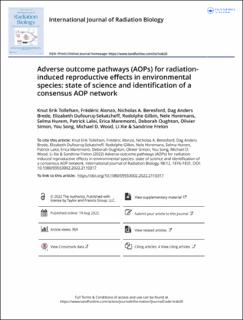| dc.contributor.author | Tollefsen, Knut Erik | |
| dc.contributor.author | Alonzo, Frederic | |
| dc.contributor.author | Beresford, Nicholas A. | |
| dc.contributor.author | Brede, Dag Anders | |
| dc.contributor.author | Dufourcq-Sekatcheff, Elizabeth | |
| dc.contributor.author | Gilbin, Rodolphe | |
| dc.contributor.author | Horemans, Nele | |
| dc.contributor.author | Hurem, Selma | |
| dc.contributor.author | Laloi, Patrick | |
| dc.contributor.author | Maremonti, Erica | |
| dc.contributor.author | Oughton, Deborah Helen | |
| dc.contributor.author | Simon, Olivier | |
| dc.contributor.author | Song, You | |
| dc.contributor.author | Wood, Michael | |
| dc.contributor.author | Xie, Li | |
| dc.contributor.author | Frelon, Sandrine | |
| dc.date.accessioned | 2023-04-19T08:23:19Z | |
| dc.date.available | 2023-04-19T08:23:19Z | |
| dc.date.created | 2022-09-22T14:25:45Z | |
| dc.date.issued | 2022 | |
| dc.identifier.citation | International Journal of Radiation Biology. 2022, 98 (12), 1816-1831. | en_US |
| dc.identifier.issn | 0955-3002 | |
| dc.identifier.uri | https://hdl.handle.net/11250/3063727 | |
| dc.description.abstract | Reproductive effects of ionizing radiation in organisms have been observed under laboratory and field conditions. Such assessments often rely on associations between exposure and effects, and thus lacking a detailed mechanistic understanding of causality between effects occurring at different levels of biological organization. The Adverse Outcome Pathway (AOP), a conceptual knowledge framework to capture, organize, evaluate and visualize the scientific knowledge of relevant toxicological effects, has the potential to evaluate the causal relationships between molecular, cellular, individual, and population effects. This paper presents the first development of a set of consensus AOPs for reproductive effects of ionizing radiation in wildlife. This work was performed by a group of experts formed during a workshop organized jointly by the Multidisciplinary European Low Dose Initiative (MELODI) and the European Radioecology Alliance (ALLIANCE) associations to present the AOP approach and tools. The work presents a series of taxon-specific case studies that were used to identify relevant empirical evidence, identify common AOP components and propose a set of consensus AOPs that could be organized into an AOP network with broader taxonomic applicability. | en_US |
| dc.language.iso | eng | en_US |
| dc.publisher | Taylor & Francis | en_US |
| dc.rights | Attribution-NonCommercial-NoDerivatives 4.0 Internasjonal | * |
| dc.rights.uri | http://creativecommons.org/licenses/by-nc-nd/4.0/deed.no | * |
| dc.title | Adverse outcome pathways (AOPs) for radiation-induced reproductive effects in environmental species: state of science and identification of a consensus AOP network | en_US |
| dc.type | Peer reviewed | en_US |
| dc.type | Journal article | en_US |
| dc.description.version | publishedVersion | en_US |
| dc.rights.holder | © 2022 The Author(s) | en_US |
| dc.source.pagenumber | 1816-1831 | en_US |
| dc.source.volume | 98 | en_US |
| dc.source.journal | International Journal of Radiation Biology | en_US |
| dc.source.issue | 12 | en_US |
| dc.identifier.doi | 10.1080/09553002.2022.2110317 | |
| dc.identifier.cristin | 2054416 | |
| dc.relation.project | Norsk institutt for vannforskning: NIVAs Computational Toxicology Program (NCTP) | en_US |
| dc.relation.project | Norges forskningsråd: 160016 | en_US |
| dc.relation.project | Norges forskningsråd: 223268 | en_US |
| cristin.ispublished | true | |
| cristin.fulltext | original | |
| cristin.qualitycode | 1 | |

